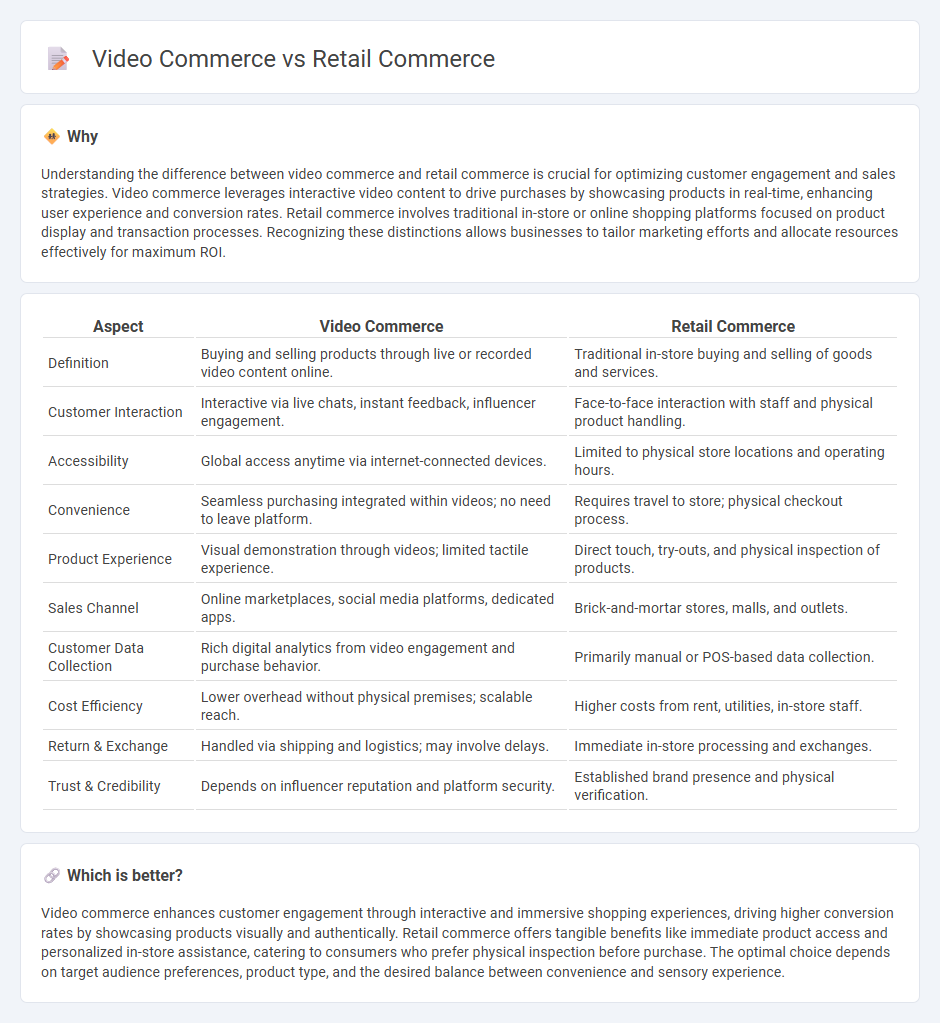
Video commerce leverages immersive multimedia experiences to engage customers, driving higher conversion rates compared to traditional retail commerce. Retail commerce relies on physical stores and face-to-face interactions, focusing on in-person shopping convenience and immediacy. Explore the evolving dynamics and advantages of video commerce to enhance your business strategy.
Why it is important
Understanding the difference between video commerce and retail commerce is crucial for optimizing customer engagement and sales strategies. Video commerce leverages interactive video content to drive purchases by showcasing products in real-time, enhancing user experience and conversion rates. Retail commerce involves traditional in-store or online shopping platforms focused on product display and transaction processes. Recognizing these distinctions allows businesses to tailor marketing efforts and allocate resources effectively for maximum ROI.
Comparison Table
| Aspect | Video Commerce | Retail Commerce |
|---|---|---|
| Definition | Buying and selling products through live or recorded video content online. | Traditional in-store buying and selling of goods and services. |
| Customer Interaction | Interactive via live chats, instant feedback, influencer engagement. | Face-to-face interaction with staff and physical product handling. |
| Accessibility | Global access anytime via internet-connected devices. | Limited to physical store locations and operating hours. |
| Convenience | Seamless purchasing integrated within videos; no need to leave platform. | Requires travel to store; physical checkout process. |
| Product Experience | Visual demonstration through videos; limited tactile experience. | Direct touch, try-outs, and physical inspection of products. |
| Sales Channel | Online marketplaces, social media platforms, dedicated apps. | Brick-and-mortar stores, malls, and outlets. |
| Customer Data Collection | Rich digital analytics from video engagement and purchase behavior. | Primarily manual or POS-based data collection. |
| Cost Efficiency | Lower overhead without physical premises; scalable reach. | Higher costs from rent, utilities, in-store staff. |
| Return & Exchange | Handled via shipping and logistics; may involve delays. | Immediate in-store processing and exchanges. |
| Trust & Credibility | Depends on influencer reputation and platform security. | Established brand presence and physical verification. |
Which is better?
Video commerce enhances customer engagement through interactive and immersive shopping experiences, driving higher conversion rates by showcasing products visually and authentically. Retail commerce offers tangible benefits like immediate product access and personalized in-store assistance, catering to consumers who prefer physical inspection before purchase. The optimal choice depends on target audience preferences, product type, and the desired balance between convenience and sensory experience.
Connection
Video commerce integrates visual content with online shopping experiences, enhancing customer engagement and driving higher conversion rates in retail commerce. Retail commerce benefits from video commerce by showcasing products through demonstrations and personalized recommendations, leading to increased trust and purchase intent. This synergy leverages interactive videos to create immersive shopping environments, bridging the gap between digital presence and physical retail interactions.
Key Terms
Point of Sale (POS)
Point of Sale (POS) technology in retail commerce primarily facilitates in-store transactions, integrating inventory management and payment processing to enhance customer experience. Video commerce leverages interactive video content to directly engage viewers, enable real-time product purchases, and streamline POS within digital platforms. Explore the evolving impact of POS innovations in these commerce models to maximize sales efficiency.
Live Streaming
Live streaming in video commerce transforms retail commerce by enabling real-time interaction between brands and consumers, boosting engagement and conversion rates significantly. Platforms like Instagram Live, TikTok, and Amazon Live showcase products dynamically, offering immediate feedback and personalized shopping experiences. Explore how live streaming is reshaping the future of retail commerce and enhancing customer journeys.
Customer Engagement
Retail commerce leverages in-store experiences and personalized customer service to drive engagement, while video commerce utilizes interactive video content and real-time communication to boost customer interaction and conversion rates. Video commerce integrates features like live streaming, shoppable videos, and instant feedback, creating immersive and dynamic shopping environments. Explore the advantages of each approach to enhance your customer engagement strategy.
Source and External Links
Retail vs. Ecommerce: How Are They Different? (2024) - Shopify - Retail commerce involves selling products directly to consumers in physical stores using point-of-sale systems, acting as the last link in the supply chain, whereas ecommerce is about selling online with digital payments and often lower overhead costs, enabling competitive pricing and reaching broader markets.
Retail - Wikipedia - Retail commerce is the sale of goods and services to consumers, typically involving purchasing goods in large quantities from manufacturers or wholesalers and selling them in smaller amounts for profit, with modern retail shifting increasingly toward multi-channel approaches including physical and online sales.
Retail vs. E-commerce: What's the Difference? | Indeed.com - Retail commerce refers to selling goods from physical locations directly to consumers, while ecommerce stores sell online and often buy directly from manufacturers, typically storing products in warehouses and competing in a global market.
 dowidth.com
dowidth.com